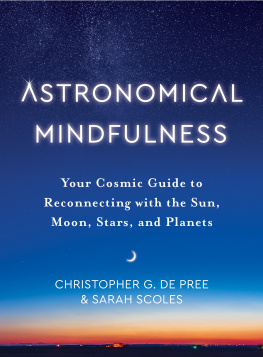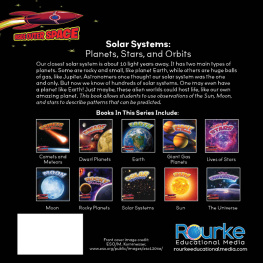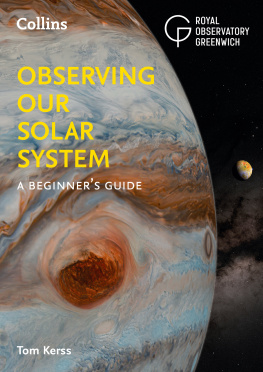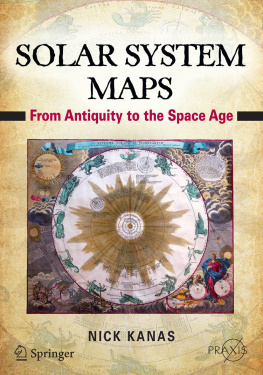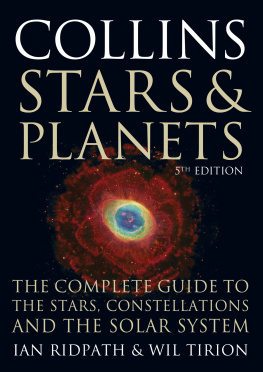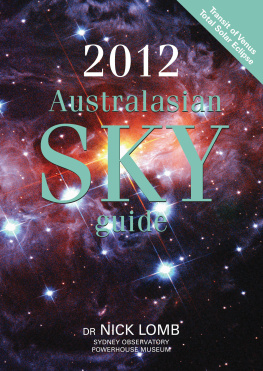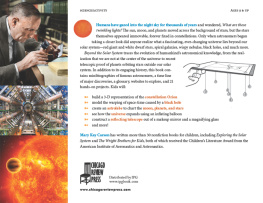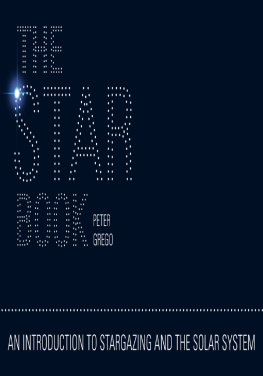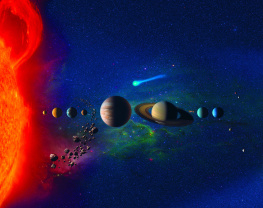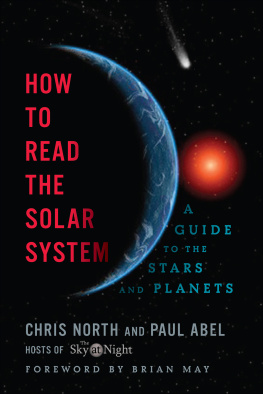
Illustration by Sergey Kamshylin/AdobeStock
To my parents, Gordon and Lenore De Pree, who inspired me to be a writer, and showed me how to be mindful of each moment.
CHRISTOPHER G. DE PREE
To my family, who told me to keep looking up.
SARAH SCOLES
Contents
Back when humans were living in communal caves and tribal encampments, we told stories about the stars, even though we didnt know what they were. When we started sailing, we used these same pinpricks of light to estimate our own location. When we began planting, we counted on the Suns position and the appearance and disappearance of certain constellations to remember when to plant and harvest our crops.
Now we tell stories about ourselves, and we use advanced tools to navigate. For the most part, someone else does the planting for us, and seasonal changes are marked by back-to-school sales and spring-cleanings. While we (arguably) understand ourselves and the planet better than we did long ago, weve mostly lost our connection to the cosmos, and to our planet. We may have apps that tell us when we can see the next Full Moon, but how often do we actually go look at it?
Many would say that to look up at the sky is a modern luxury, not a necessity. Worse, it sounds like a waste of time in a productivity-driven culture. As a result, the press of daily life has largely erased our understanding of the motions of the Sun, Moon, stars, and planets. We are go, go, go, but where, exactly, are we going? Where have we come from? What does it all mean? Attention to the cosmos just might provide some answers.
Plenty of astronomy books can tell you about the constellations and the positions of the planets, but unless youre taking a college course or youre just especially curious, there isnt a pressing need to explore the galaxy. However, there are benefits that have nothing to do with the reasons our ancient ancestors looked to the skies: looking at the night sky brings you into the here and now. When youre focusing on the stars, youre not scrolling through social media, zoning out in front of the TV, or staring at your out-of-control inbox. Everything slows down. You breathe easier. You feel calmer. This book is a practical guide to understanding the fundamental ways in which our home planet moves through the solar system, and how these motions determine our perception of time and space. But perhaps more important, it is a book that will help you be more mindful about your presence in the universe.
Mindfulness has become a buzzword, often clouded by bland, corporate jargon, or overcomplicated and lumped in with the practice of meditation, which can feel daunting and unattainable. But the true definition of mindfulness is actually quite simple. Thich Nhat Hanh, often called the father of mindfulness, put it this way in The Miracle of Mindfulness: Dont drink your tea like someone who gulps down a cup of coffee during a work break. Drink your tea slowly and reverently, as if it is the axis on which the whole Earth revolvesslowly, evenly, without rushing toward the future. Live the actual moment. Only this actual moment is life. In other words, its really focusing on where and how youcorporeally and cognitivelyare situated in and interacting with your surroundings, noticing yourself, the environment, and the relationship between the two. Often mindfulness brings to mind terrestrial exampleslike that half-full glass of water that youre sipping. But mindfulness can apply equally to celestial matters. Where and how are your brain and body relating to the particular happenings in the sky above? How do the photons of light warming your skin actually connect you in a real way to the Suns roiling surface?
The acts of looking up, noting whats going on, and contemplating how it all relates to you are mindful by their very nature, because mindfulnessby its very natureis about being open to, curious about, and attentive to what is happening around and above you right now. When you are mindful in your observations, you are living life in the moment. And understanding and noticing the sky above can help you to be more informed, engaged, and mindful during each day and night.
These actions are particularly important in a world that is increasingly fast and loud, and in a society that tells us our value lies in what we produce and the status we can achieve. In their book Mindfulness, Mark Williams and Danny Penman suggest that instead of eliminating pleasurable activities to make more time for productivity and work, we should intentionally find ways to make our daily lives more enjoyable. They propose three such ways: (1) do something pleasurable, (2) do something that will give you a sense of satisfaction or mastery over your life, and (3) act mindfully. Astronomical observations can accomplish all of the above. Simply gazing at the clear night sky will provide a sense of pleasure. Following through on any exercise in this book will provide a sense of mastery and achievement. And careful observation of your present place in this moment is one way to act mindfully and be a more-aware citizen of the universe.
The takeaways in this book are profound and yet primitive, just like mindfulness itself. In some ways, mindfulness is just a fancy term for paying attention. At its core, it is both simple and significant. Mindfulness is synonymous with awareness, writes expert Jon Kabat-Zinn. We are colossally out of shape when it comes to perception and awareness, whether oriented outwardly or inwardly or both. We get back in shape by exercising our faculties for paying attention over and over again, just like a muscle. This book can help you to be aware of your interaction with the universe through observation, to exercise those muscles day and night, and to feel more alive not just as a person on Earth but as a human in the universe. Astronomical mindfulness is simply practicing mindfulness when you observe the universe, in the same way that you might mindfully make tea or wash the dishes. When youre observing the universe, that should be what youre doing. When youre looking at the Moon, say to yourself, I am looking at the Moon, even though it seems obvious. Be present in that magnificent moment.
HOW TO USE THIS BOOK
We dont really have to notice anything about the sky to lead a successful modern life, other than perhaps menacing clouds or impending darkness. And because we dont have to, and were busy, we usually dont. But the practices in the following pages will provide a reason to pay attention anyway, and to let your thoughts flow through, accepting them, as you might in traditional meditation.
The book is organized into five parts, one that introduces you to your surroundingsGetting Orientedand then four more that focus on observations related to the Sun, Moon, stars, and planets. You dont need to work through each part in order, but its probably a good idea to start with the chapters. Each chapter is rated with one, two, or three asterisks. These reflect the order of complexity and time required, with one asterisk being the least complex and taking the least time to complete. Each activity also has a mindfulness exercise, with one or two of the following labels to signify its focus:
PRESENT MOMENT exercises help you focus on whats going on in your body or in your environment right now.
CLOSE OBSERVATION exercises ask you to notice the details of something you might otherwise let slip by.
BREATHING exercises help you bring attention to the present and to your circumstances through that most human of tasks: respiration.

